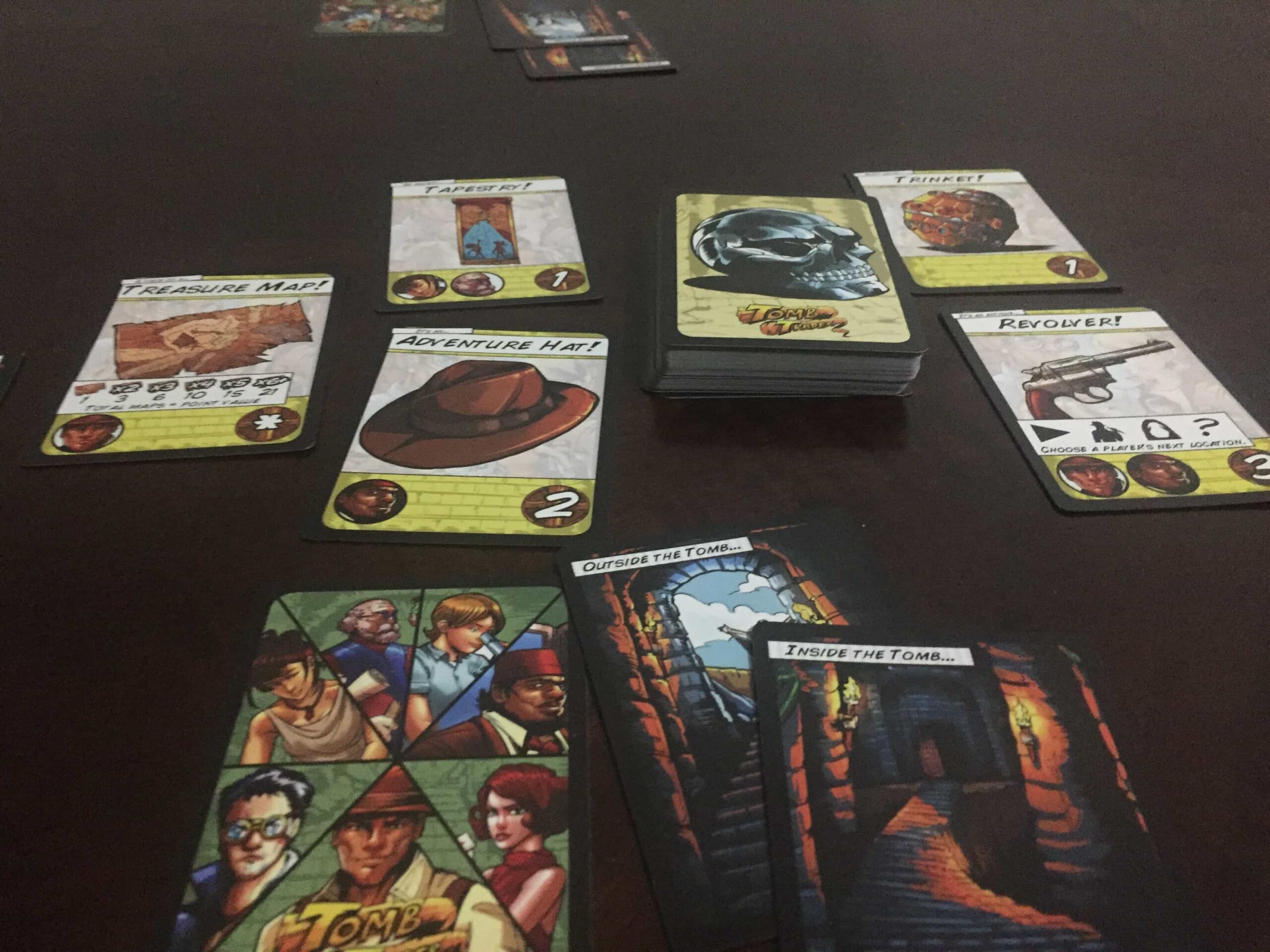Tomb Trader is a 3-6 player negotiation game designed by Asher Stuhlman and published by Level 99 Games.
I can’t say that I get a ton of negotiation games to the table. However, I still believe that any gamer with a decent sized collection, especially if they host regular games nights, should have one or more of them on hand. Negotiation games are versatile, can handle large player counts, and can be very fun with the right crowds. The king of the hill in negotiation games, of course, is currently Cosmic Encounter. However, that one involves a lot of setup, can run fairly long, and has a mind-blowing amount of content at this point.
Tomb Trader, on the other hand, gives you a small deck of cards and some coins. Also, you can set it up and get a full play in about 15-20 minutes. These are all great things, so let’s see if this small game packs some good negotiating punch.
How to play Tomb Trader
In Tome Trader, players act as shady treasure collectors, poised to take advantage of the hard work of some poor archaeologists who risked life and limb for their loot. Each players starts the game with a character card that they keep secret. The character cards indicate which treasures their characters want the most (i.e., what will score bonus points). The Hunter!, for example, naturally wants weapons and medicine to assist in his further adventurers, the Artist! wants all rare artifacts she can carry, etc.
Yes, I put the exclamation points there on purpose. The game’s art and overall style evokes 1920s pulp action where every! page! held! excitement!
In each round of the game, players will reveal loot from a loot deck and place them in one of two spots – “inside the tomb” or “outside the tomb” (cool names that, in game terms, really mean ‘left’ and ‘right’). Players then secretly choose where they want to go and reveal simultaneously.
If you end up in a spot by yourself, awesome! You get half of whatever’s there. Whoever else went to the same spot, though, has one minute to negotiate with their competitors to see who can get what. If the players can’t decide by the end of the minute, no one gets anything. In the negotiation phase, there’s lots of room for players to plead, cajole, lie, bluff, and do all those fine negotiating things we know and love in these games.
A single game lasts 6 or 7 rounds (depending on player count). With each successive round, more loot comes out of the deck, which raises the stakes on negotiations. At the end of the game, whoever has the most gold – representing by gold chips as well as gold on the loot and character cards – wins!
The loot deck doesn’t contain a lot of surprises, for the most part. Most of the deck is comprised of various prizes from archaeological digs that are valuable to different characters. Every once in a while, though, a card will pop up that will hinder a player, or grant someone a one-time ability to gently mess with a player’s next turn. There’s no stealing loot, though, so the backstabbery in this game is fairly minimal.
What I liked about Tomb Trader
The 15-minute listed playtime drew me in, and I have to say that the box did not lie (unlike most boxes). Furthermore, the 15 minutes are packed with fun! The game does not overstay its welcome and felt engaging throughout. By the time the rounds start to feel repetitive (you are, after all, doing the exact same thing every turn), the game is over.
The game has a fun theme and art style. I don’t know if I loved that every! single! card! had! an! exclamation! point! I didn’t know that Ancient Brushes! were so exciting. However, after a few rounds, I stopped noticing that.
In terms of mechanisms, negotiation games don’t have to do too much heavy lifting. The players do most of the work. Mechanisms in negotiation games need to a) establish a clear incentive structure and b) allow players space to effectively lie and misrepresent, if they so choose. I thought this game did both of those things well. The scoring system is very simple and easy to understand. Also, it shines a bright light at what treasures you should go for, which helps limit analysis paralysis.
Because the characters are secret, you have the freedom to lie and overplay/ underplay how much you want various available treasures during negotiation. I am a terrible liar, so most players sniffed out my character very easily. However, some players were excellent liars and were able to finagle some needed loot at a reduced rate on some turns. I feel it is a total credit to this game that skilled players were able to keep their identity a secret until the very end.
Some people wonder why the game didn’t contain a sand timer or a coin, two items that the game calls for at various points (especially the former). I wasn’t bothered by that. I generally have those things on me at most times. So I don’t mind not having them in the box if that means I get a cheaper game.
What I didn’t like about Tomb Trader
My main criticism of Tomb Trader might not be very fair since the designers clearly sought to make a simple game. However, I did find that the game had room for more mechanical complexity that’s not present here. For example, I would have liked to have been able to steal cards from other players, or swap with them, or sneak into one of the tomb spaces and grab one treasure before negotiating began. I felt like it would have been easy to include advanced options like that as modular, optional pieces.
Also, if you don’t like negotiation games, Tomb Trader will do nothing for you. Some of the bigger negotiation games, like Cosmic Encounter, include other elements that might appeal to more gamers like player powers, simulated combat, etc. In this game, what you see is what you get.
Again, those aren’t necessarily criticisms of the game. That’s just stuff to look out for. The game knows what it wants to be, which is a simple filler negotiation game. This game clears that low bar very, very easily.
Final Verdict
As someone who, as I said above, does not play a lot of negotiation games, I really enjoyed this one! I think it clearly holds its own alongside classic games in this genre like Dragon’s Gold or Bohnanza, while contributing some unique wrinkles in terms of style and mechanisms.
SCORE
7.0
Play
REVIEW
7

